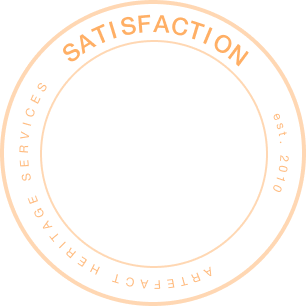

Q: You've been with Artefact for almost 7 years now, what are a couple of project highlights and why?
A: Early in my time in NSW and after several years working on a project to widen a remote and hazardous highway, I was able to collect the Aboriginal artefacts from the side of the highway, that had prevented road works from progressing.
I placed the artefacts in the hands of the supervising Aboriginal Uncle in anticipation of some sort of congratulations. His words were unexpected and taught me a deep and humbling lesson: “Thank god that’s over, now we can build this road so that our young people stop dying on it”.
I realised that from the Uncle’s perspective, and from a humanitarian one too, the insistence on and privileging of Aboriginal heritage legislation as defined by white people, has the potential to be self-serving at the expense of Aboriginal lives and values.
"Thank god that’s over, now we can build this road"
On a dig in Dapto, I (as I always do) asked the local Aboriginal representative whether he would like to welcome us or acknowledge country before we commenced work, and if there were any local stories he could share. He did, and instantly enlivened the surrounding landscape from being purely an ecological and geological formation to one that was filled with Dreaming and in which ancestral and Dreamtime figures were visibly embodied. The excavation became a totally different experience.
Pursue What Matters
Q: At work you seem to be somewhat of a mentor to the graduate placements and interns. What advice would you give younger people entering the heritage sector?
A: Don’t lose sight of what brought you into the sector in the first place. It’s all too easy to wake up after years and realise that your career might have moved you ‘upwards’ but is no longer feeding your passions or dreams.
Don’t feel stuck. According to the University of Queensland, most people will have between 5-7 separate careers in their life (and 16 jobs). 1 The most important person to be happy, satisfied, motivated and engaged in what you do every day, is you. Don’t be scared to pursue what really matters.
Image: Michael discussing a complete hand axe with a member of the Peak Hill Local Aboriginal Land Council. The axe was found during the construction of the Inland Rail. Image courtesy of ARTC Inland Rail.

The Future
Q: You’ve worked in Aboriginal heritage and Aboriginal archaeology for a long time now. What are some of the recent developments you’ve noted in the industry and where do you see the future?
A: Things are very different across the continent.
Victoria has a compliance system which seven years after implementation is still groundbreaking. NSW in contrast has compliance legislation that is nearly 50 years old, is part of the National Parks and Wildlife Act and never involved Aboriginal people in its drafting. Despite this, there have been marked positive changes outside the compliance space within individual companies in NSW. Artefact’s Aboriginal Cultural Heritage Officer program is a major development. It looks to build and empower a cadre of Aboriginal people to take leadership in the management of their heritage, in their communication with community and in enriching our understanding of Aboriginal cultural values.
A similar program is run by Comber Associates, largely motivated by Jillian Comber’s PhD thesis findings that Aboriginal cultural heritage in NSW is an active process of cultural dispossession.
Image: Michael participating in a Smoking Ceremony at the Fragrance Garden in Sydney prior to the 2022 NSW Aboriginal Archaeology Forum.

A Sign of Quality
Q: Currently you’re the Treasurer with the NSW branch of the Australian Association of Consulting Archaeologists (AACAI) and a Research Fellow with the Australian Institute of Archaeology (AIA). Why is it important to have associations such as this?
A: In other professions, including law, medicine, accounting, and education, it is not enough to simply have a university degree in order to practice. It is a professional body that issues certification of such a right (e.g. the Medical Board of Australia). AACAI membership is currently the only hurdle-based archaeological membership in Australia, requiring peer evaluation of work by an applicant. This acts as a symbol of quality that offers potential clients with an assurance of reliability.
The AIA offers facilities and a research and publication environment for people who are outside the university sector, but nevertheless want to continue their academic growth.
Image: Michael holding the Loftus Lane street sign during archaeological excavation works in the Sydney CBD.

My Artefact
Q: In the photo you’re holding a small silver cup. What is it and why is this item important to you?
A: This is a Kiddush cup used in Jewish ceremony to mark festivals. It was given to me at birth and is an artefact that contains many happy and sometimes bittersweet memories of occasions in the past.
It symbolises to me the way that artefacts generally contain cultural and emotionally-laden significance far beyond their functional meaning.
Image: Michael holding his Kiddush cup.

"I am passionate about the power that knowledge of the past can have to change our present and future for the better, and to help redress historical inequities."
Dr Michael Lever








